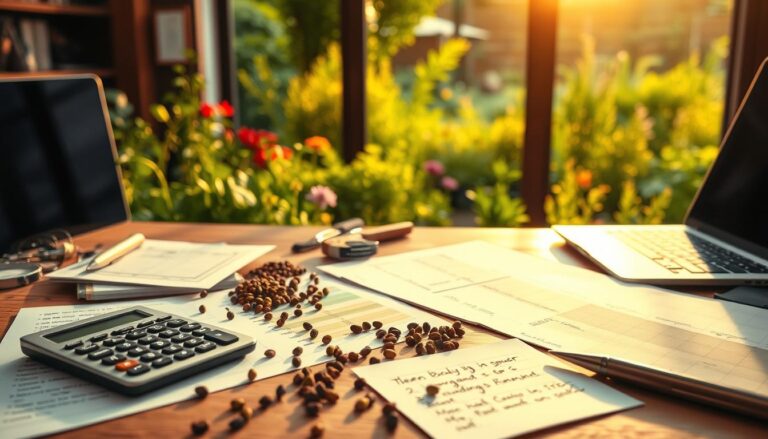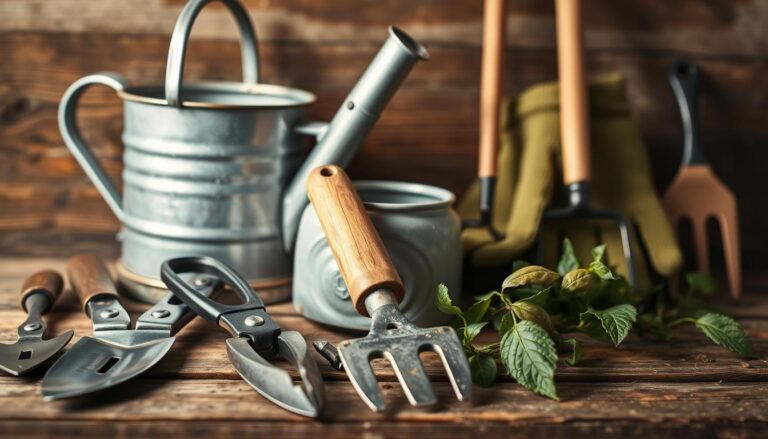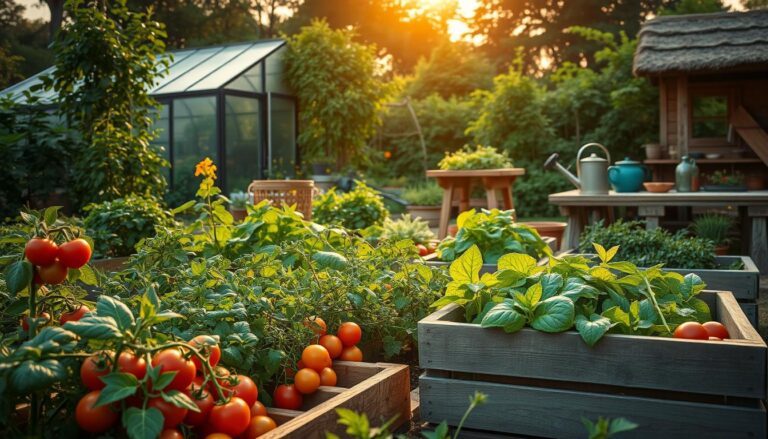Growing an organic garden is rewarding. It gives you fresh produce and supports a sustainable lifestyle. With organic gardening tips, you can have a garden without synthetic chemicals or pesticides.
Starting with sustainable gardening can seem hard for beginners. But, with the right help, anyone can grow a beautiful garden. This article will show you how, with useful advice and organic gardening tips to start your journey.
By using sustainable gardening for beginners methods, you’ll get fresh, healthy food. You’ll also help the environment.
Understanding the Principles of Organic Gardening
Organic gardening avoids synthetic helpers. It works with nature instead. This method respects the natural world and aims to keep it healthy.
What Makes a Garden “Organic”
An organic garden doesn’t use synthetic pesticides or fertilizers.
No Synthetic Pesticides or Fertilizers
Organic gardeners avoid these chemicals. This protects the soil, air, and water. It makes a safer space for plants and people.
Working with Nature’s Systems
Organic gardening means understanding and working with nature. It uses methods like crop rotation and companion planting. These practices boost biodiversity and soil health.
Benefits of Growing Your Own Organic Produce
Growing your own organic produce has many advantages.
Health and Nutritional Advantages
Organic food is often more nutritious. It’s also free from harmful chemicals. This makes it a better choice for your health.
Environmental Impact
Organic gardening is good for the environment. It helps reduce carbon footprint and protects natural resources.
Common Misconceptions About Organic Gardening
Some think organic gardening is too hard or yields less. But, with the right techniques, organic gardens can be as productive. They are also better for the environment.
How to Start Your Organic Garden: Planning Your Space
Planning well is key to a successful organic garden. When starting your organic gardening journey, think carefully about the space you have.
Assessing Your Available Space
First, look at the space you have for your garden. Think about its size, shape, and how the sun hits it.
Urban, Suburban, and Rural Considerations
Every place has its own gardening challenges and chances. Urban gardens might need creative solutions like vertical gardening or using containers on balconies. Suburban areas often have more room for a variety of gardens. Rural places can handle big organic farms.
Determining Sun Exposure and Microclimates
It’s important to know how the sun and microclimates work in your garden. Watch how sunlight changes to see which areas get more sun or shade. This helps pick the right plants for each spot.
Choosing Between In-Ground, Raised Beds, or Container Gardens
Choose the garden type that fits your space and needs best. In-ground gardens work well for big areas. Raised beds are good for better soil and drainage. Container gardens are great for small or odd-shaped spaces.
Space Requirements for Different Garden Types
Each garden type needs different amounts of space. For example, carrots need deep soil, but leafy greens do well in shallower containers. Knowing these needs helps plan your garden well.
With careful planning, you can make a productive and sustainable organic garden. It will use sustainable landscaping ideas and green gardening techniques.
Essential Tools and Materials for Organic Gardening
To grow a healthy organic garden, you need the right tools and materials. Organic gardening is more than avoiding chemicals. It’s about making a space that’s good for your plants and the planet.
Basic Gardening Tools
Every gardener needs basic tools to care for their garden. You’ll need a trowel for planting, pruning shears for cutting plants, a garden fork for mixing soil, and a way to water like a can or hose.
Quality vs. Budget Options
Choosing gardening tools can be tough. You might want quality tools that last longer but cost more. Or, you might pick cheaper tools that need more fixing. For example, a good pair of pruning shears can save you money in the long run.
| Tool | Quality Option | Budget Option |
|---|---|---|
| Pruning Shears | Fiskars Power-Lever Tree Pruner ($50) | AmazonBasics Pruning Shears ($10) |
| Garden Fork | Ames 4-Tine Garden Fork ($30) | True Temper 4-Tine Garden Fork ($20) |
Organic Materials and Supplies
Organic gardening uses natural stuff like compost to make soil better. You’ll also need organic mulch, ways to keep pests away, and natural fertilizers.
Sustainable Alternatives to Conventional Gardening Products
Choosing eco-friendly options is important for gardening. Use recycled stuff for paths, reuse containers, and pick biodegradable products.
DIY Garden Solutions
Doing things yourself can save money and help the planet. Make your own compost tea or use things from home to keep pests away. This way, you use less commercial stuff.
By picking the right tools and materials, gardeners can make their organic gardening better. This helps the environment and makes gardening more effective.
Building Healthy Soil: The Foundation of Organic Gardening
A healthy garden starts with good soil. It’s full of life and nutrients, helping plants grow well. This ecosystem is key for a garden to thrive.
Understanding Soil Types and Testing
Soil comes in types like clay, silt, sand, and loam. Each has its own needs and challenges. Knowing your soil type is the first step to a fertile garden.
Creating Nutrient-Rich Soil with Compost
Composting turns waste into a valuable soil amendment. It uses organic materials like kitchen scraps and leaves. This makes the soil better for plants.
Natural Soil Amendments for Organic Gardens
There are natural ways to improve soil. Manure, peat moss, and cover crops add nutrients and help microbes. They make the soil healthier.
Regional Considerations for Soil Building
Climate, soil type, and local rules affect soil care. In dry areas, add moisture-retaining materials. In wet areas, focus on drainage.
Building healthy soil is key to a productive garden. Using these tips for sustainable gardening and organic gardening tips will help. You’ll create a garden that’s good for you and the planet.
- Test your soil regularly to understand its needs.
- Add organic matter like compost to improve soil fertility and structure.
- Use natural amendments suitable for your region and soil type.
Selecting Plants for Your Organic Garden
Starting a successful organic garden begins with picking the right plants. This step is key to your garden’s success and lasting health.
Choosing Plants Suited to Your Climate and Growing Zone
Knowing your local climate and growing zone is vital. Plants that match your area’s weather and sunlight will need less care. For example, in hot summers, picking plants that can handle the heat is a smart move.
Understanding Plant Families and Crop Rotation
Crop rotation is a key part of organic gardening. It means switching plants from different families to keep the soil healthy. For instance, switching between Solanaceae (tomatoes, peppers), Brassicaceae (broccoli, kale), and Fabaceae (beans, peas) helps the soil stay rich.
Planning Multi-Season Rotations
Good crop rotation plans for several seasons. A simple plan might be:
- Season 1: Plant heavy feeders like tomatoes.
- Season 2: Follow with legumes that fix nitrogen.
- Season 3: Plant a cover crop to enrich the soil.
This keeps the soil fertile and healthy.
Heirloom vs. Hybrid Seeds in Organic Gardening
Choosing between heirloom and hybrid seeds matters. Heirlooms bring genetic diversity and unique tastes. Hybrids offer disease resistance and more yield, but their seeds can’t be saved.
Seed Saving Practices
Seed saving is crucial for organic gardeners. It helps keep heirloom varieties alive and adapts them to local conditions. Saving seeds from healthy plants ensures future crops are of high quality.
| Seed Type | Characteristics | Seed Saving |
|---|---|---|
| Heirloom | Open-pollinated, diverse, unique flavors | Yes |
| Hybrid | High yield, disease resistance | No |
When planning your organic garden, think about these points. Choosing the right plants and practices will lead to a thriving, sustainable garden that gives you fresh food for years.
“The garden is a love song, a duet between a human being and Mother Nature.” – Jeff Cox
Planting Techniques for Organic Gardens
Organic gardening needs careful planning to get a good harvest. The right planting methods help plants grow well and produce more.
Starting Seeds Indoors vs. Direct Sowing
Choosing between starting seeds indoors or directly in the garden is a big decision. Starting seeds indoors helps them grow strong, away from pests and bad weather.
Direct sowing is easier and lets plants grow where they’ll stay. It depends on the plant and the weather.
Creating an Organic Seed Starting Setup
If you start seeds indoors, setting up a good space is key. Use organic mixes and make sure they get enough light, maybe with grow lights.
Proper Spacing and Planting Depths
Spacing and depth are important for plant health. Too close together means plants fight for food and get sick easier.
Plant seeds twice as deep as they are wide. Space them as each plant needs.
Companion Planting for Natural Pest Control
Companion planting is smart in organic gardens. It means growing plants together to help each other. For example, marigolds keep nematodes away, and basil makes tomatoes taste better.
Beneficial Plant Combinations
Some good pairs are tomatoes with carrots and sage, or cucumbers with dill. These help plants grow and keep pests away.
Natural Watering and Irrigation Methods
Starting a sustainable garden means using smart watering strategies. As an organic gardener, it’s key to pick natural and efficient ways to water. This keeps your garden healthy and growing well.
Water Conservation Techniques
Using drip irrigation systems is a top way to save water. These systems send water straight to the plants’ roots. This cuts down on evaporation and runoff.
Drip Irrigation Systems
Drip irrigation is very good at saving water. It waters the roots directly, helping plants grow strong. And it saves water, which is very important.
Rainwater Harvesting Systems
Setting up rainwater harvesting systems is another green choice. These systems collect and store rainwater for your garden. This cuts down on the need for groundwater and city water.
Proper Watering Practices for Different Plants
Every plant needs different amounts of water. Knowing what each plant needs is key. Adjust your watering schedule to meet their needs.
Seasonal Watering Adjustments
Changing your watering based on the season is also important. Plants might need more water in hot summers. But in cooler months, they might need less.
Organic Pest and Disease Management
Effective organic pest and disease management is key for a thriving garden. Organic gardening avoids chemical pesticides and fertilizers. It aims to create a balanced ecosystem where plants, beneficial insects, and microorganisms live together.
Identifying Common Garden Pests and Diseases
The first step is to identify pests and diseases. Common pests include aphids, slugs, snails, and caterpillars. Diseases range from fungal infections like powdery mildew to bacterial spot infections.
Prevention as the First Line of Defense
Prevention is crucial. This includes crop rotation, removing weeds, and ensuring good air circulation. These steps help prevent pests and diseases.
Natural Predators and Beneficial Insects
Nature has its own pest control. Encouraging natural predators and beneficial insects is vital for organic pest management.
Creating Habitat for Helpful Creatures
To attract beneficial insects, create a welcoming habitat. Plant diverse flowers for nectar and pollen. Also, keep some areas of the garden untidy for nesting.
Homemade Organic Pest Control Solutions
Sometimes, you need to intervene. Homemade organic pest control solutions are effective and often made from kitchen ingredients.
When and How to Intervene
Knowing when to intervene is key. Regularly monitor your garden and act at the first sign of trouble. Solutions include soap solutions, garlic, or hot pepper concoctions.
Here’s a comparison of common homemade pest control solutions:
| Solution | Target Pest | Ingredients |
|---|---|---|
| Soap Solution | Aphids, Whiteflies | Mild Dish Soap, Water |
| Garlic Spray | Aphids, Caterpillars | Garlic, Water, Optional: Soap |
| Neem Oil | Wide Range of Pests | Neem Oil, Water |
By following these eco-conscious gardening tips, you can keep your garden healthy and chemical-free.
Harvesting and Preserving Your Organic Bounty
The moment of harvest is exciting in organic gardening. It shows all your hard work and dedication. It’s key to pick your crops right to keep their quality and nutrition.
Knowing When to Harvest Different Crops
Knowing when to pick your crops is key for the best taste and nutrition. Each crop has its own sign of readiness. For example, leafy greens are ready when they’re fully colored. Root vegetables are best when they’re 1 to 3 inches in diameter, depending on the type.
Harvest Timing for Maximum Nutrition
Harvesting at the right time boosts your produce’s nutrition. Many fruits and veggies are most nutritious just before they’re fully ripe. For instance, tomatoes picked when still a bit green have more vitamin C.
Organic Methods for Food Preservation
Preserving your harvest lets you enjoy your garden’s fruits all year. You can use canning, freezing, and drying to do this.
Canning, Freezing, and Drying Techniques
Canning involves sealing food in containers and heating it to kill bacteria. Freezing stops microorganisms from growing. Drying removes water, making it hard for bacteria and mold to grow. Each method has its own techniques to keep food quality and safety.
Seed Saving for Next Season
Seed saving is crucial for a self-sustaining garden. Saving seeds from your best plants ensures a steady supply of crops suited to your garden.
Creating a Self-Sustaining Garden Cycle
A self-sustaining garden cycle is more than just saving seeds. It includes crop rotation, composting, and natural pest control. These practices make your garden resilient and productive, needing less outside help over time.
By using these tips for sustainable gardening and green gardening techniques, you can have a rich harvest. Your organic garden will stay healthy and productive.
Conclusion: Enjoying the Fruits of Your Organic Garden
Growing an organic garden is rewarding. It gives you fresh, healthy food and helps the planet. By using eco-friendly gardening, you’re choosing a healthier life and a greener future.
We’ve talked about organic gardening basics. This includes planning your garden and harvesting your crops. We’ve also covered how to make soil healthy, pick the best plants, and control pests naturally. These tips help beginners create a green garden that’s good for you and the earth.
Starting your organic garden is exciting. Begin with a few plants and learn as you go. With time and effort, you’ll enjoy the fruits of your labor. So, start today and enjoy growing your own organic food.
FAQ
What are some eco-friendly gardening practices I can implement in my organic garden?
How can I improve the soil health in my organic garden?
What are some sustainable landscaping ideas for my organic garden?
How do I choose the right plants for my organic garden?
What are some tips for sustainable gardening for beginners?
How can I manage pests and diseases in my organic garden without using synthetic chemicals?
What are some green gardening techniques I can use to reduce my environmental impact?
How can I preserve my organic harvest to enjoy it throughout the year?

Sortemdia nasceu com o propósito de trazer alegria e oportunidades para todos por meio de sorteios gratuitos de prêmios incríveis. O site tem como missão oferecer experiências acessíveis, divertidas e justas para quem deseja concorrer a produtos, serviços e brindes sem pagar nada por isso. Acreditamos que a sorte pode bater à porta de qualquer pessoa — e no Sortemdia, ela pode chegar com apenas um clique.



